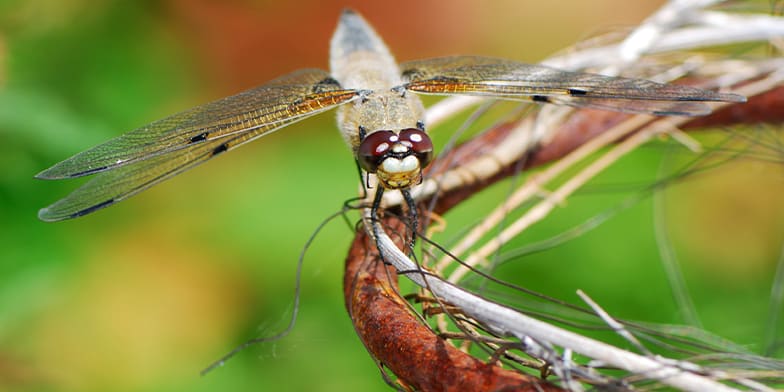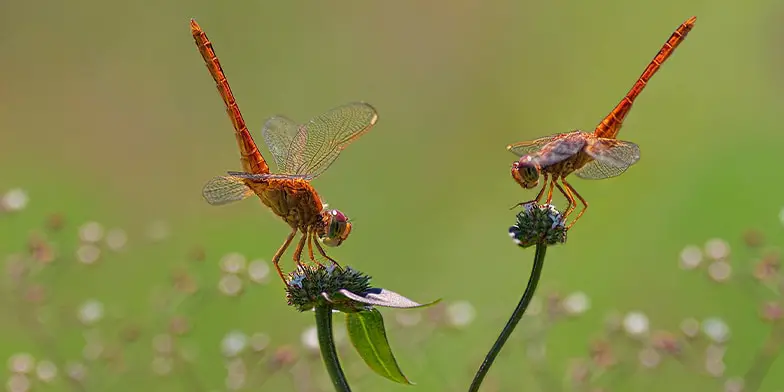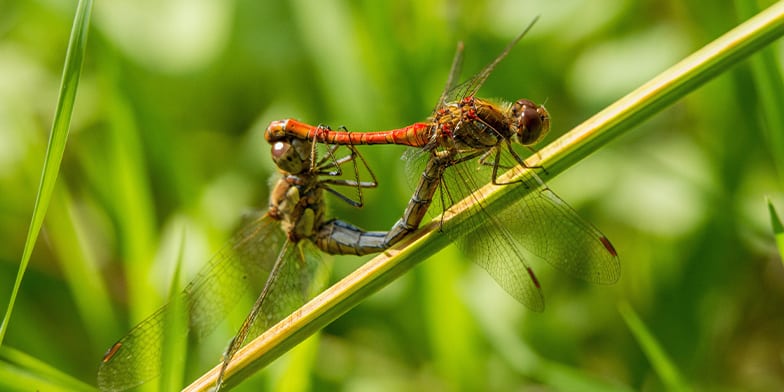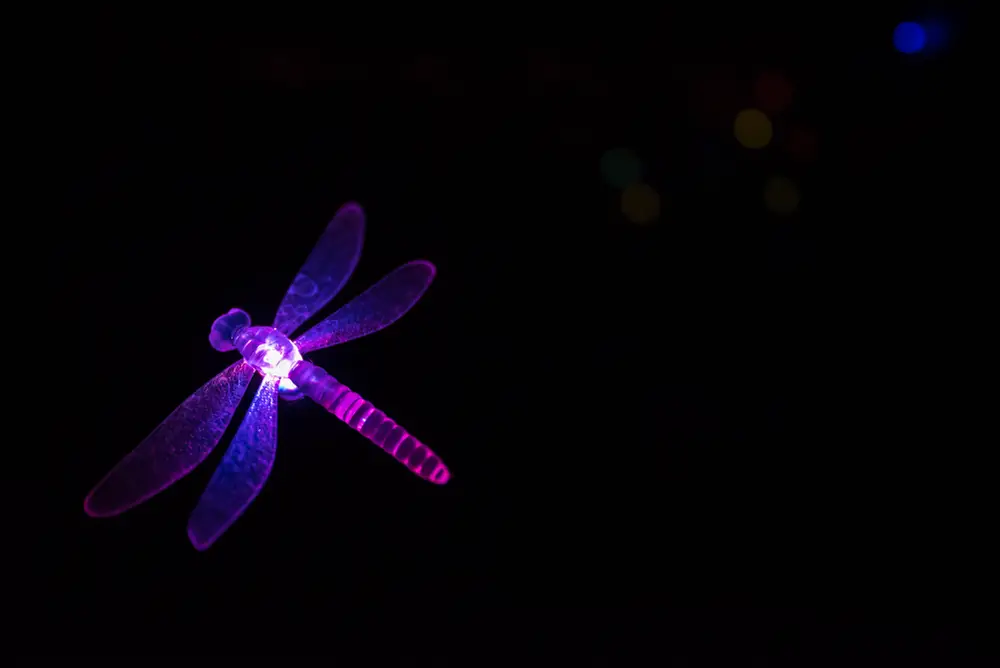
Dragonflies are remarkable insects. Although most of us will be familiar with their beautiful and colorful adult forms, we might not know too much about why they do what they do! One good example of this is why we always seem to find them near water. Why don’t they fly to other places?
Dragonflies rely on calm or still bodies of water, such as ponds, marshes, lakes, and slow rivers. It is in these bodies of water that the dragonfly will find their food, a potential mate, and a safe place to lay their eggs.
This article is going to explore the interesting relationship between the dragonfly and water, and even how you might be able to attract dragonflies to your own yard (depending on where you live!).
Do Dragonflies Find Their Food in Water?
One reason dragonflies are found near water so often is that most of their food is found there. Dragonflies are carnivorous insects, and from the time they hatch they quickly become fierce and agile hunters. As they develop in the relative safety of their nursery, the bigger nymphs will tend to prey upon the smaller ones.
Yep, you read that correctly! Dragonflies are cannibals! Interestingly (or unfortunately, if you’re an insect) they’re not the only ones. As we’ve talked about with cockroaches, cannibalism in the insect world is far more common than you might expect.
If you’re wondering how these dragonfly newborns are able to hunt so soon after hatching, they have a fascinating method of fast propulsion that lets them both hunt and escape predators. Using special gills in their rectum, they can suck in water and then blast it back out – rocketing them forward!
This trick is necessary for survival because dragonfly nymphs don’t just have to worry about their bigger siblings, but also other predators such as fish, birds, other insects, and even common woodland creatures like fogs, raccoons, and foxes. Nymphs who stay too close to the edge of the pond or river are likely to become snacks.
Dragonfly nymphs also possess extendable jaws that make it easy for them to catch invertebrates and some vertebrates in the water, such as young damselflies, water fleas, snail eggs, bloodworms, newt larvae, frog tadpoles, and even small fish! Sometimes the hunter can become the hunted.
If food in their pond is growing scarce, they may do something remarkable and use their rocket gills to propel themselves onto dry land, all in the search for sustenance. As they mature, their appetites will grow with them, and dragonfly nymphs can consume their own body weight in other insects in less than 30 minutes.

As adults, the hunting prowess of the dragonfly becomes formidable. They move on from the underwater pond critters and set their sights on other mature insects. Their legs are shaped the way they are so that they can form a basket shape with which to catch other flying insects like flies, mosquitoes, mayflies, gnats, moths, and sometimes even bees and butterflies.
You might have noticed that many of the creatures on the dragonfly’s menu, like gnats and mosquitoes, are also most often be found around still water for similar reasons as the dragonfly. Calm water is the perfect environment for many types of insect.
How Do People Interfere With Their Water?
For the most part, dragonflies don’t mind our presence. In fact, many back yards and front yards have lovely decorative ponds that suit their needs perfectly. Still water is easy to come by and difficult to interfere with. It’s far easier to disrupt the lives of creatures who rely on flowing water, such as with some man-made dams.
The most harmful impact humankind has had on the dragonfly is incidental. When dragonflies see shiny man-made objects like polished gravestones, cars, or signs, it’s not uncommon for the poor insects to mistake these things as the bright surface of water and lay their eggs on them. Since these places are not at all suitable environments for young dragonflies, the eggs that are laid on objects with no nearby water will die.
If you would like to create a small suitable environment for dragonflies in your backyard, whether it’s because you just really like to watch them or because you have a mosquito problem, you can create a suitable habitat by installing a freshwater pond and planting a variety of blooming flowers. That takes care of both the home and the food source!
Why do Dragonflies Lay Their Eggs in Water?
Another reason why you will find dragonflies most often near water is that they live the bulk of their lives in or near it. When a male dragonfly and female dragonfly mate, the calm waters of a pond is usually be the safest place for the eggs to hatch because they won’t dry out, and they are relatively safe from predators.

When the female dragonfly is laying her eggs, she will lay them in the plant that is in the water, or if the pond doesn’t have plants in the water, she will just lay them directly into the pond. Sometimes female dragonflies will just lay the eggs near the water, while other species will explore deep into the pond or marsh to find a good surface.
It’s vital for the eggs to be in or very close to water because once the eggs hatch into larvae – or nymphs – they can only live in the water. The still, or at least calm, waters of ponds and marshes are the perfect nurseries for dragonfly nymphs because they won’t be washed away or slammed into rocks.
It should also be noted that when the female dragonfly lays her eggs, she will lay thousands of them at a time! Not only does this help ensure a sufficient amount of eggs make it to their first birthday (relatively speaking), it really provides many of those nymphs with a key source of nutrients.
All of a sudden, when those eggs hatch two weeks later, the pond, slow river, or marsh gets a little crowded. Is it any wonder then that the siblings start eating each other? It’s easy to get a little crabby when you’re crammed. At the very least, there’s no love lost between dragonfly siblings.
Do Dragonflies Dry Out?
Adult dragonflies don’t dry out without a nearby source of calm water, but they won’t often travel very far from one. This is because the water is where the great proportion of their food lives, and also because they have to very quickly find a mate and lay new eggs. Some adult dragonflies only live for about two months, so it wouldn’t be good for them to take too much time exploring the world. They have more important things to do!
However, that isn’t to say some don’t look for other viable water holes.
Five species in particular – the Green Darner, Spot-Winged Glider, Variegated Meadowhawk, Wandering Glider, and the Black Saddlebag dragonflies all migrate. These dragonflies will either move on their own or migrate together in a swarm. As food becomes scares, as winter approaches and the days get colder, or sometimes just to follow the rain that replenishes their breeding grounds, they will range out to find a new home.
Conclusion:
The ecosystem surrounding calm bodies of water are the perfect conditions for dragonflies to flourish. From the time they are born to the time they mate and die, the water is virtually their entire world. Although some species of dragonfly will explore to find new places to live, it’s to the water they will always return.
Still and calm waters are where they find the majority of their food, it’s where they find safety, where they find their mate, and the space to produce the next generation of dragonflies.
The still water is also where they fulfill their final duty to their ecosystem. It’s where they will die, and provide other creatures with food. The cycle continues.
Resources:
- Dragonfly Life Cycle (dragonfly-site.com)
- What Do Dragonflies Eat? Article Explains Dragonfly Food. (dragonfly-site.com)
- What Are Dragonfly Nymphs? (allthingsnature.org)
- Do Birds Eat Dragonflies? – Find Out In Our New Blog Post (richardalois.com)
- 10 Fascinating Facts About Dragonflies (thoughtco.com)
- How to Create a Dragonfly Garden (treehugger.com)
Driven by a passion for those tiny creatures that rule our world, we at Bug Domain strive to be your go-to resource for information on insects.



